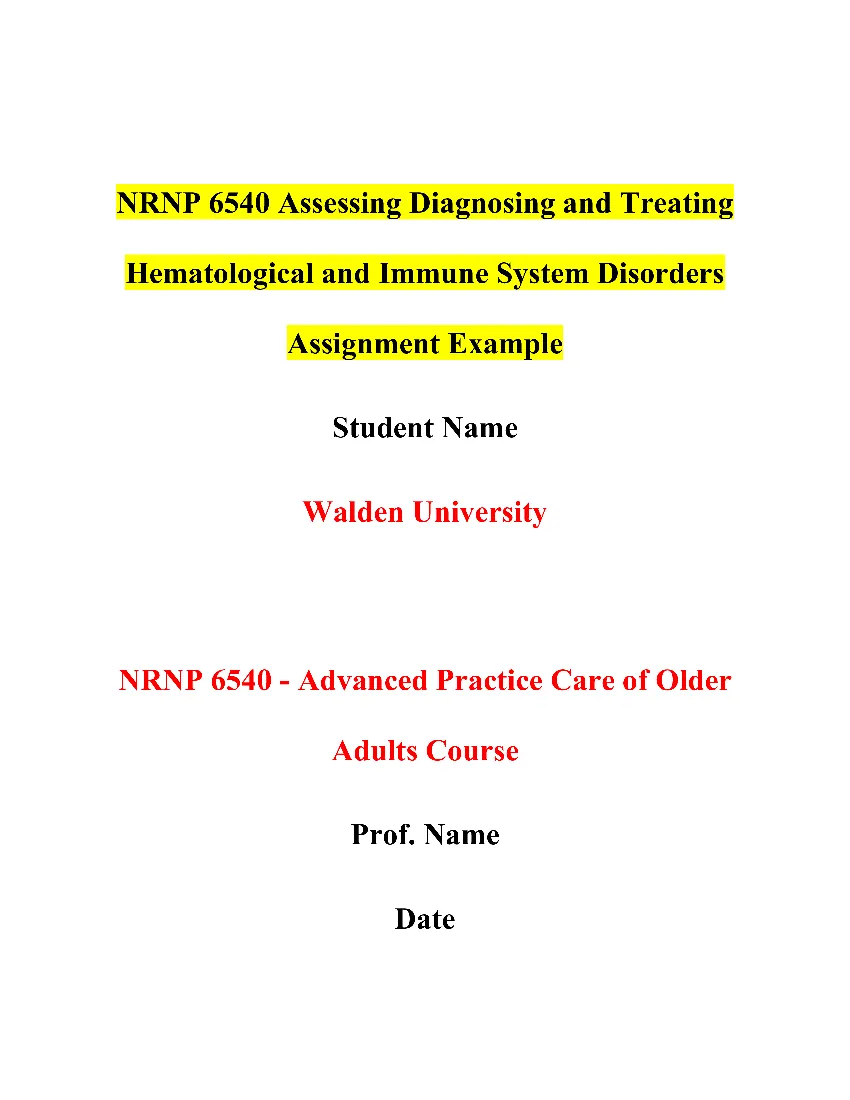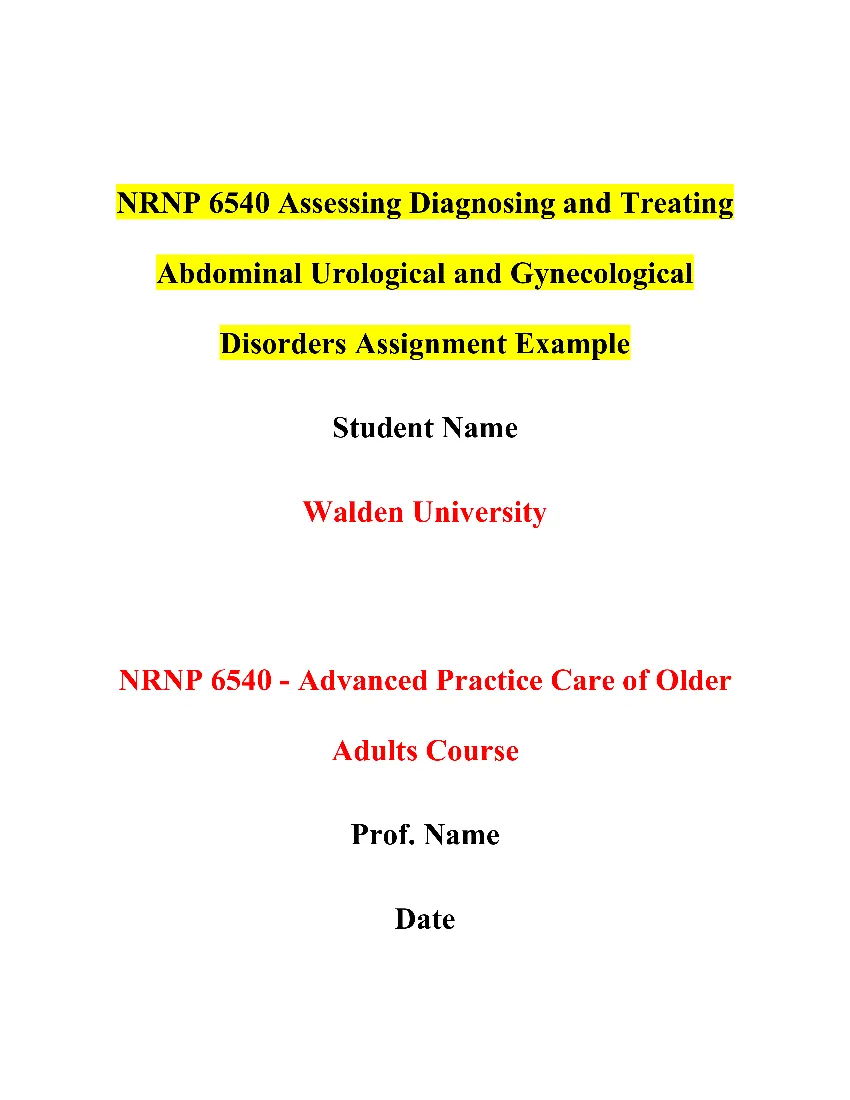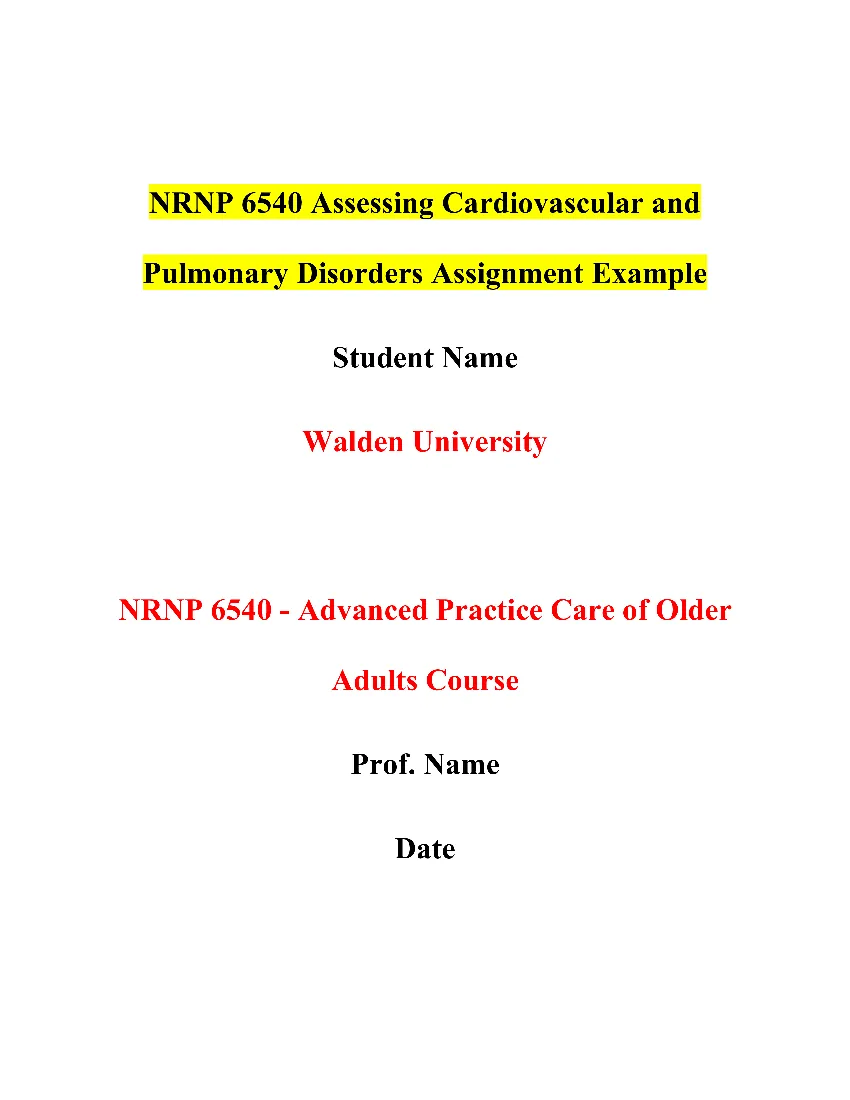NRNP 6635 Discussion the Psychiatric Evaluation and Evidence-Based Rating Scales

NRNP 6635 is a graduate-level nursing course that focuses on the advanced practice of psychiatric-mental health nursing. The course is designed to prepare nurse practitioners to assess, diagnose, and treat individuals with psychiatric disorders across their lifespans.
One of the key topics covered in NRNP 6635 is psychiatric evaluation, which involves the systematic collection and analysis of information about a patient’s mental health status. Psychiatric evaluation typically includes a comprehensive clinical interview, a review of medical and psychiatric history, and the use of standardized assessment tools to measure symptoms and functioning.
Assessment tools are a critical component of psychiatric evaluation, as they provide standardized and objective measures of symptoms and functioning that can guide diagnosis and treatment planning. NRNP 6635 covers a variety of assessment tools, including self-report measures, clinician-administered measures, and performance-based measures.
Throughout NRNP 6635 course, students are taught to critically evaluate the psychometric properties of assessment tools, including their reliability, validity, sensitivity, and specificity. They also learn to integrate assessment results with other clinical information, such as patient history, presenting symptoms, and context, to make accurate diagnoses and treatment plans. This enables students to select the most appropriate assessment tool for a given clinical situation and to interpret assessment results accurately.
In addition to these assessment tools, NRNP 6635 covers other evidence-based rating scales and measurement instruments that are commonly used in psychiatric evaluation, such as the Hamilton Rating Scale for Depression, the Brief Psychiatric Rating Scale, the Global Assessment of Functioning Scale, and the Positive and Negative Syndrome Scale for Schizophrenia.
Overall, NRNP 6635 provides students with a comprehensive understanding of psychiatric evaluation and assessment tools, which is essential for effective and evidence-based psychiatric-mental health practice.
Examples of Common Assessment/Rating Tools covered in NRNP 6635
Some commonly used rating scales include the Quick Inventory of Depressive Symptomatology (QIDS), Mini-Mental State Examination (MMSE), Delirium Rating Scale, the Brief Psychiatric Rating Scale (BPRS), the Hamilton Anxiety Rating Scale (HAM-A), The Positive and Negative Syndrome Scale (PANSS), Young Mania Rating Scale (YMRS), Montgomery-Asberg Depression Rating Scale (MADRS), the Patient Health Questionnaire-9 (PHQ-9), Generalized Anxiety Disorder 7-item scale (GAD-7), and Beck Depression Inventory (BDI).
Check out another task that our nursing assignment writing experts have assisted another student on Asthma Exacerbation Gabriel Martinez shadow health Objective Data
The Quick Inventory of Depressive Symptomatology (QIDS)
The Quick Inventory of Depressive Symptomatology (QIDS) is appropriate to use with clients during the psychiatric interview when assessing for major depressive disorder (MDD) or evaluating the severity of depressive symptoms. It is a brief self-report instrument that covers all of the clinical domains used in making a diagnosis of MDD based on DSM-IV-TR criteria, making it a useful tool for identifying and tracking depressive symptoms in clinical practice.
Using the QIDS during the psychiatric interview can be helpful to a nurse practitioner’s psychiatric assessment in several ways. Firstly, it can provide a standardized measure of depressive symptoms that can be used to monitor treatment response and track symptom changes over time. Secondly, it can help to identify specific areas of impairment or dysfunction associated with depressive symptoms, such as changes in sleep or appetite, which can guide treatment planning. Finally, it can aid in making a diagnosis of MDD by providing a standardized measure of symptom severity that can be compared to established diagnostic criteria.
There is evidence to support the use of the QIDS in clinical practice. A study by Trivedi et al. (2004) compared the QIDS to other commonly used depression rating scales and found that it demonstrated good reliability, validity, and sensitivity to change. Another study by Fava et al. (2004) found that the QIDS was sensitive to differences in depressive symptom severity and was able to differentiate between remission, response, and non-response to treatment. Additionally, the QIDS has been shown to be a valid measure of depressive symptoms in various populations, including individuals with co-occurring substance use disorders and older adults (Rush et al., 2000; Sheehan et al., 2010).
Overall, the QIDS is a useful tool for assessing depressive symptoms in clinical practice, and its psychometric properties have been demonstrated in several studies. Using the QIDS during the psychiatric interview can help nurse practitioners to make accurate diagnoses, monitor treatment responses, and tailor treatment plans to specific areas of dysfunction associated with depressive symptoms.
The Mini-Mental State Exam (MMSE)
The Mini-Mental State Exam (MMSE) is appropriate to use with clients during the psychiatric interview when assessing for cognitive impairment, particularly in older adults. It is a brief, standardized test that assesses various domains of cognitive function, such as orientation, memory, attention, and language.
Using the MMSE during the psychiatric interview can be helpful to a nurse practitioner’s psychiatric assessment in several ways. Firstly, it can identify the presence and severity of cognitive impairment, which can inform diagnostic and treatment decisions. Secondly, it can help to identify specific areas of cognitive dysfunction, such as memory or language deficits, that may be associated with underlying conditions such as dementia or delirium. Finally, it can help to monitor cognitive function over time, allowing for early detection of changes that may require intervention.
There is evidence to support the use of the MMSE in clinical practice. A systematic review by Folstein et al. (2010) found that the MMSE had good sensitivity and specificity for detecting cognitive impairment and was able to differentiate between normal cognition, mild cognitive impairment, and dementia. Another study by Pinto et al. (2019) found that the MMSE was effective in detecting cognitive impairment in older adults with depression, highlighting the importance of assessing cognitive function in this population.
Overall, the MMSE is a useful tool for assessing cognitive function in clinical practice, particularly in older adults. Its psychometric properties have been demonstrated in several studies, and it can inform diagnostic and treatment decisions, identify specific areas of cognitive dysfunction, and monitor cognitive function over time.
The Delirium Rating Scale
The Delirium Rating Scale (DRS) is a standardized tool used to assess the severity of delirium, a common and serious neuropsychiatric syndrome that is often underrecognized in clinical settings. The DRS assesses various domains of delirium, such as attention, orientation, memory, and language, and provides a total score that reflects the overall severity of delirium.
The DRS is appropriate to use with clients during the psychiatric interview when assessing for delirium or suspected delirium, particularly in older adults or those with comorbid medical conditions. It can be helpful to a nurse practitioner’s psychiatric assessment in several ways. Firstly, it can assist in identifying the presence and severity of delirium, which can inform diagnostic and treatment decisions. Secondly, it can help to monitor the course of delirium over time, allowing for early detection of changes that may require intervention. Finally, it can be used to evaluate the effectiveness of interventions for delirium.
There is evidence to support the use of the DRS in clinical practice. A systematic review by Adamis et al. (2018) found that the DRS had good psychometric properties and was able to reliably identify and measure the severity of delirium in both clinical and research settings. Another study by Inouye et al. (2014) found that the DRS was effective in identifying delirium in hospitalized older adults and that its use was associated with improved clinical outcomes and reduced healthcare costs.
Overall, the DRS is a useful tool for assessing the severity of delirium in clinical practice, particularly in older adults or those with comorbid medical conditions. Its psychometric properties have been demonstrated in several studies, and it can assist in diagnostic and treatment decisions, monitor the course of delirium over time, and evaluate the effectiveness of interventions.
The Brief Psychiatric Rating Scale (BPRS)
The Brief Psychiatric Rating Scale (BPRS) is a commonly used rating scale in psychiatric evaluation that assesses the severity of symptoms in patients with mental illness.
When screening physical health in psychiatric evaluation, it is important to ask questions related to the patient’s medical history, current medications, allergies, and any recent surgeries or hospitalizations. Additionally, assessing a patient’s well-being or ill-being is important for the Psychiatric-Mental Health Nurse (PMHN).
The PMHN should ask questions related to the patient’s sleep patterns, appetite changes, energy levels, and overall mood. It is also important to assess any suicidal ideation or self-harm behaviors. By asking these questions and conducting a thorough physical examination, the PMHN can identify any underlying medical conditions that may be contributing to the patient’s mental health symptoms and provide appropriate treatment.
Electronic Health Records (EHRs), Electronic Medical Records (EMRs), Personal Health Records (PHRs), Medical Practice Management Software (MPM), and many other healthcare data components collectively have the potential to improve the quality of care by providing information critical for patient life.
The National Institutes of Health (NIH) recently announced the “All of Us” initiative that aims to collect one million or more patients’ data such as EHR, including medical imaging, socio-behavioral, and environmental data over the next few years. This initiative can provide relevant solutions for improving public health by collecting big data relating to past, present, or future physical/mental health.
The Hamilton Anxiety Rating Scale (HAM-A)
The Hamilton Anxiety Rating Scale (HAM-A) is a clinician-based questionnaire that measures the severity of anxiety symptoms. The HAM-A consists of 14 items designed to assess the severity of a patient’s anxiety. Each item contains a number of symptoms, and each group of symptoms is rated on a scale of zero to four, with four being the most severe. All of these scores are used to compute an overarching score that challenges the original version of the scale over time.
When screening physical health in psychiatric evaluation, assessing a patient’s well-being or ill-being is important for the PMHN. The HAM-A can be used as part of this assessment to measure the severity of anxiety symptoms. Respondents indicate how they currently feel, and responses are rated on a 4-point Likert scale and range from 0 to 3. The HAM-A is one of many recommended measures for anxiety disorders.
The PMHN should ask questions related to the patient’s sleep patterns, appetite changes, energy levels, and overall mood. It is also important to assess any suicidal ideation or self-harm behaviors. Furthermore, when using HAM-A rating scale in psychiatric evaluation, the clinician should ask questions related to the patient’s level of anxiety and its impact on their daily life.
The HAM-A questionnaire includes items such as anxious mood, tension, fears, insomnia, somatic complaints related to anxiety, and others. By asking these questions and conducting a thorough physical examination along with HAM-A assessment tool, the PMHN can identify any underlying medical conditions that may be contributing to the patient’s mental health symptoms and provide appropriate treatment.
The Positive and Negative Syndrome Scale (PANSS)
The Positive and Negative Syndrome Scale (PANSS) is a medical scale used for measuring the symptom severity of patients with schizophrenia. It is considered the “gold standard” for measuring how well treatment is working. The PANSS test takes about 30 to 40 minutes and consists of two parts. In the first section, the practitioner will ask about the patient’s medical history and symptoms. In the second part, the practitioner may ask questions that try to find out how severe the patient’s symptoms are.
When assessing a patient’s physical health, doctors may use other tests in addition to PANSS. For example, doctors may use the Calgary Depression Scale for Schizophrenia to check for symptoms of depression that could affect daily life or might even lead to thoughts of suicide. Doctors may also use Clinical Global Impression-Schizophrenia (CGI-SCH), which has been adapted from the more general Clinical Global Impression score used to diagnose other psychiatric illnesses.
The PANSS questionnaire includes items such as delusions, hallucinations, disorganized thinking, and anxiety/depression symptoms among others. By asking these questions and conducting a thorough physical examination along with PANSS assessment tool, the PMHN can identify any underlying medical conditions that may be contributing to the patient’s mental health symptoms and provide appropriate treatment.
Young Mania Rating Scale (YMRS)
The Young Mania Rating Scale (YMRS) is a rating scale used to measure the severity of manic symptoms in patients with bipolar disorder. The scale has 11 items and is based on the patient’s subjective report of their clinical condition over the previous 48 hours. Some of the questions that may be asked when screening physical health in psychiatric evaluation include:
- Are you experiencing any physical symptoms such as headaches, stomachaches, or fatigue?
- Have you experienced any changes in appetite or weight?
- Are you currently taking any medications or supplements?
- Have you had any recent illnesses or injuries?
- Do you have a history of chronic medical conditions such as diabetes, hypertension, or heart disease?
Furthermore, when using YMRS rating scale in psychiatric evaluation, the clinician should ask questions related to manic symptoms such as elevated mood and grandiosity. The YMRS questionnaire includes items such as elevated mood, and increased motor activity/energy level among others.
In addition to this, the mental status examination should include general awareness and responsiveness of the patient along with descriptions of their behavioral and cognitive functioning. It includes descriptions of the patient’s orientation (knowing current date and location), intelligence, memory, judgment and thought process along with their behavior and mood assessment.
By asking these questions and conducting a thorough physical examination along with YMRS assessment tool based on the patient’s subjective report of his or her clinical condition over the previous 48 hours, the PMHN can identify any underlying medical conditions that may be contributing to the patient’s mental health symptoms and provide appropriate treatment.
Montgomery-Asberg Depression Rating Scale (MADRS)
The Montgomery-Asberg Depression Rating Scale (MADRS) is a commonly used tool for assessing depression severity. It consists of 10 items that evaluate mood, feelings of guilt or worthlessness, suicidal ideation, sleep disturbances, appetite changes, concentration difficulties, and energy levels over the past week.
The MADRS is a self-reported questionnaire that can be used to monitor depression severity. It has two categories: severity of illness and degree of change. The assessment tool is adapted from the original Prodromal Questionnaire, which is a 92-item self-report tool.
The MADRS stratifies the severity of depressive episodes in adults and should only be used in adults aged 18 years or older. It rates based on a clinical interview with the patient, and clinical judgment should be used to determine whether the rating lies on the defined scale steps (0, 2, 4, 6 points) or between them (1, 3, 5 points).
When using the MADRS to screen physical health in psychiatric evaluation, some questions that can be asked include:
- Have you lost interest in activities that you previously enjoyed?
- Do you feel sad or depressed most of the time?
- Have you experienced changes in your appetite or weight?
- Do you have trouble sleeping or sleeping too much?
- Do you feel tired or lack energy most of the time?
- Have you experienced feelings of worthlessness or guilt?
- Have you had difficulty concentrating or making decisions?
These questions can help assess a patient’s mental state and provide insight into their overall well-being.
The Patient Health Questionnaire-9 (PHQ-9)
The Patient Health Questionnaire-9 (PHQ-9) is a self-administered tool used to assess depression. It is a brief questionnaire that incorporates DSM-IV depression criteria with other leading major depressive symptoms. The PHQ-9 consists of nine questions that ask about the frequency of symptoms experienced over the last two weeks. The questions are related to mood, sleep, appetite, energy, and concentration.
When screening physical health in psychiatric evaluation, it is important to assess a patient’s well-being or ill-being. The PHQ-9 can be used as a screening tool for depression in primary care settings. It can also be used by mental health professionals as part of their treatment plan with patients. The PHQ-9 can be administered in print form or digital versions and is available in over 30 languages.
The PHQ-9 has been validated as a reliable and valid tool for assessing depression. Studies have shown that PHQ-9 scores >10 had a sensitivity of 88% and specificity of 88% for Major Depressive Disorder. The final question on the PHQ-9 asks about thoughts of hurting oneself or being better off dead. This question counts if given any score other than zero, regardless of the duration of the symptom, and is a criterion for Major Depressive Disorder.
Generalized Anxiety Disorder 7-item scale (GAD-7)
The Generalized Anxiety Disorder 7 (GAD-7) is a seven-item self-report anxiety questionnaire designed to assess the patient’s health status during the previous two weeks. It is commonly used as a measure of general anxiety symptoms across various settings and populations.
The GAD-7 can identify probable cases of a generalized anxiety disorder (GAD) and assess symptom severity. It has strong criterion validity for identifying possible cases of GAD. The degree to which the test measures what it claims to be measuring is known as construct validity, and Löwe et al. (2008) substantiated the one-dimensional structure of the GAD-7 and its factorial invariance for gender and age.
When using the GAD-7, patients are asked about how often they have been bothered by feeling nervous, anxious or on edge; not being able to stop or control worrying; worrying too much about different things; trouble relaxing; being so restless that it’s hard to sit still; becoming easily annoyed or irritable; and feeling afraid as if something awful might happen. Each item has four response options ranging from “not at all” to “nearly every day,” with scores ranging from 0 to 21. A score of 10 or greater indicates clinically significant anxiety symptoms.
Beck Depression Inventory (BDI)
The Beck Depression Inventory (BDI) is a widely used psychometric test for measuring the severity of depression. It consists of 21 multiple-choice self-report inventory questions that relate to symptoms of depression such as hopelessness, irritability, guilt, feelings of being punished, and physical symptoms such as fatigue, weight loss, and sleep disturbance. The BDI can be easily adapted in most clinical conditions for detecting major depression and recommending an appropriate intervention.
The BDI is designed as a screening device rather than a diagnostic tool. When scoring the test, a value of 0 to 3 is assigned for each answer. The total score is then compared to a key to determine the severity of depression. The standard cut-off scores range from 0-63 with higher scores indicating more severe depression.
Questions to ask when screening physical health in psychiatric evaluation
When conducting a psychiatric evaluation, screening physical health is crucial for the effective diagnosis and treatment of patients. Poor physical health can lead to an increased risk of developing mental health problems, while poor mental health can negatively impact physical health. By asking the right questions, PMHNPs can better understand their patients’ mental and physical health, leading to more effective diagnosis and treatment. Asking questions about well-being or ill-being allows the PMHNP to assess the patient’s quality of life, feelings of anxiety, distress, motivation, and energy. Additionally, questions about safety should be included to ensure the patient’s safety and well-being.
Below, we will examine the questions to ask when screening physical health in psychiatric evaluation and assessing a patient’s well-being or ill-being.
Screening Physical Health:
The PMHNP should screen the patient’s physical health by asking questions about their health concerns, sleeping habits, appetite, and eating habits. This is important because poor physical health can lead to an increased risk of developing mental health problems, and poor mental health can negatively impact physical health. Furthermore, some physical diseases are linked to psychotropic treatment. Thus, it is essential to ask questions such as “What health concerns do you have?” “How are your sleeping habits over the past 4 weeks?” “Have you noticed any changes, difficulty sleeping?” “How would you describe your current appetite?” and “Have your eating habits altered in any way?”
Assessing Well-being or Ill-being:
The PMHNP should also ask questions about the patient’s well-being or ill-being. This will allow them to assess the patient’s quality of life, feelings of anxiety, distress, motivation, and energy. Sample questions could include “Have you had little pleasure or interest in the activities you usually enjoy over the past few months?” and “Have you been concerned by low feelings, stress, sadness, and nervousness?”
Ensuring Safety:
As safety is a priority for the provider, questions about suicide, self-harm, homicide, domestic violence, and abuse must be included in the interview. Inquiring about any previous suicide attempts, self-harm, or thoughts of harming themselves or others is essential. If necessary, the provider should take steps to ensure the patient’s safety and involve other healthcare professionals in the patient’s care plan.
Relationships and Belonging:
Finally, the PMHNP should ask questions about the patient’s relationships and sense of belonging. This will allow them to understand the patient’s feelings and beliefs about their society and environment, to know if they feel accepted, supported, and possess meaningful relationships. Possible questions that can be asked include “Do you have friends, family, or otherwise?” “How do you feel about others around you?” and “Tell me about how you have been feeling about your relationships recently.”
Importance of screening physical health in psychiatric evaluation
When conducting a psychiatric evaluation, it is essential to screen the patient’s physical health as it is the first step in diagnosis and treatment. The interconnectedness of physical and mental health is well-established. Poor physical health can lead to an increased risk of developing mental health problems, while poor mental health can negatively impact physical health, increasing the risk of some conditions. In addition, some physical diseases are linked to psychotropic treatment. Consequently, individuals with serious mental illness experience a heightened rate of preventable and treatable physical illnesses and comorbidities such as obesity, cardiovascular disease, and diabetes.
To screen physical health effectively, clinicians should ask the patient questions about their general health concerns. For example, what health concerns do they have, and have they noticed any changes in their health status? Additionally, it is essential to inquire about the patient’s sleeping habits over the past four weeks, including any changes or difficulty sleeping. Changes in appetite and eating habits should also be assessed, as this may indicate physical health issues.
In addition to asking these questions, the use of evidence-based rating scales in psychiatric evaluation can help clinicians to assess the patient’s mental health status and guide treatment decisions. Rating scales provide standardized measurements of symptom severity and can assist in identifying treatment targets and tracking the patient’s progress over time.
It is important to note that rating scales should be used in conjunction with clinical evaluation and an individualized treatment plan. They are not a substitute for a comprehensive assessment of the patient’s mental health status and should be used as a tool to aid in diagnosis and treatment decisions.
Get Expert Writers to Work on Your NRNP 6635 Assignment Paper from nursingcustomwriting.com
You can be sure that a seasoned professional with a background in nursing will write your paper when you order from nursingcustomwriting.com.
Hiring a professional nursing writer to assist you in creating your NRNP 6635 assignment paper can help you in many ways.
When you hire a professional writer, it’s much easier to get high-quality content that has been well researched and written in a clear and concise way.
If you’re a nursing student in need of nursing essay help, you can rest assured that the experts at nursingcustomwriting.com will provide you with top-notch service at a price you can afford.
Whether you need help starting from scratch or revising a previously written paper, nursing term paper writers are here to help.
Nursing students who need a reliable writing service can get help with their assignments from the nursing custom paper writers at our company.



 NRNP 6540 Week 8 Assignment; Assessing, Diagnosing, and Treating Hematological and Immune
NRNP 6540 Week 8 Assignment; Assessing, Diagnosing, and Treating Hematological and Immune NRNP 6540 Week 5 Assignment: Assessing, Diagnosing, and Treating Abdominal, Urological, and Gynecological Disorders
NRNP 6540 Week 5 Assignment: Assessing, Diagnosing, and Treating Abdominal, Urological, and Gynecological Disorders NRNP 6540 Week 4 Assignment: A 67-Year-Old with Tachycardia and Coughing
NRNP 6540 Week 4 Assignment: A 67-Year-Old with Tachycardia and Coughing

 NRS 429VN VARK Analysis Paper Assignment Brief
NRS 429VN VARK Analysis Paper Assignment Brief
 NURS 6053 IO005 Assignment Module 5: Change Implementation and Management Plan
NURS 6053 IO005 Assignment Module 5: Change Implementation and Management Plan